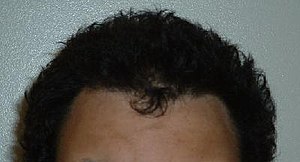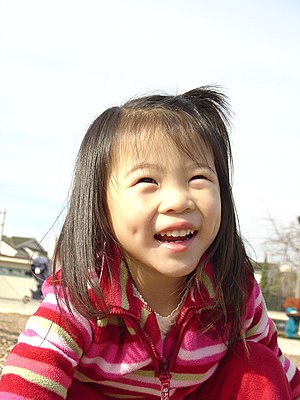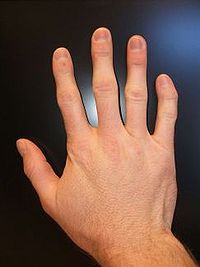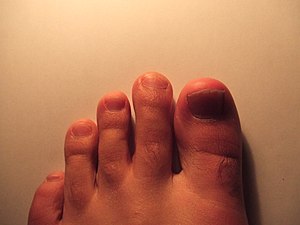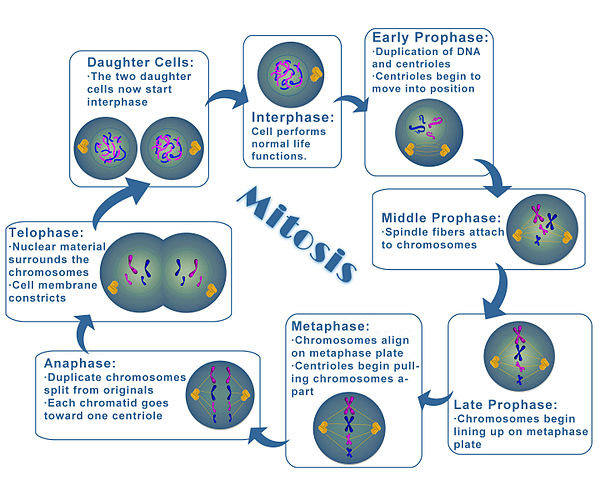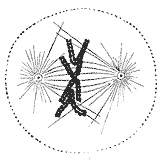Especialidades JA/Herencia/Respuestas
| Herencia | ||
|---|---|---|
| Asociación General
|
Destreza: 3 Año de introducción: 2004 |
|
Requisitos
1
Heredity refers to the transfer of biological characteristics from a parent organism to offspring, and is practically a synonym for genetics, as genes are now recognized as the carriers of biological information.
A simpler way to describe "heredity" is simply how traits are passed on from parent to offspring.
2
3
3a
A chromosone is a thread like linear strand of DNA and associated proteins in the nucleus of eukaryotic cells that carries the genes and functions in the transmission of hereditary information. Chromosomes are located in the nucleus. Chromosomes are the blueprint for our bodies.
A good video explaining how cells and their chromosomes work. http://youtu.be/xUrlreMaUrs.
3b
It is a segment of a chromosome responsible for a trait,it is also a piece of DNA with specific sequence which is responsible for a phenotype and any change (mutation) in the sequence results in respective change in the phenotype, and it is a sequence of DNA that contains the information for ("Codes for") the construction of a protein (genotype).Genes are located on the chromosomes.
Genes are inherited as units, with two parents dividing out copies of their genes to their offspring. This process can be compared with mixing two hands of cards, shuffling them, and then dealing them out again. Humans have two copies of each of their genes, and make copies that are found in eggs or sperm—but they only include one copy of each type of gene. An egg and sperm join to form a complete set of genes. The eventually resulting child has the same number of genes as their parents, but for any gene one of their two copies comes from their father, and one from their mother.
Many traits are inherited in a more complicated way than the example above. This can happen when there are several genes involved, each contributing a small part to the end result. Tall people tend to have tall children because their children get a package of many alleles that each contribute a bit to how much they grow. However, there are not clear groups of "short people" and "tall people", like there are groups of people with brown or red hair. This is because of the large number of genes involved; this makes the trait very variable and people are of many different heights. Despite a common misconception, the green/blue eye traits are also inherited in this complex inheritance model. Inheritance can also be complicated when the trait depends on interaction between genetics and environment. For example, malnutrition does not change traits like eye color, but can stunt growth.
4
4a
An allele is any one of a number of viable DNA codings of the same gene occupying a given position on a chromosome. Humans have paired chromosomes in their somatic cells, and these contain two copies of each gene. In some cases the two copies of the gene are identical — that is, have the same allele. In other cases, the two copies are different. Humans inherit two copies of every gene, one copy comes from the mother, and the other comes from the father.
The effects of the mixing depend on the types (the alleles) of the gene. If the father has two copies of an allele for red hair, and the mother has two copies for brown hair, all their children get the two alleles that give different instructions, one for red hair and one for brown. The hair color of these children depends on how these alleles work together. If one allele overrides the instructions from another, it is called the dominant allele, and the allele that is overridden is called the recessive allele. In the case of a daughter with alleles for both red and brown hair, brown is dominant and she ends up with brown hair.
Although the red color allele is still there in this brown-haired girl, it doesn't show. This is a difference between what you see on the surface (the traits of an organism, called its phenotype) and the genes within the organism (its genotype). In this example you can call the allele for brown "B" and the allele for red "b". (It is normal to write dominant alleles with capital letters and recessive ones with lower-case letters.) The brown hair daughter has the "brown hair phenotype" but her genotype is Bb, with one copy of the B allele, and one of the b allele.
Now imagine that this woman grows up and has children with a brown hair man who also has a Bb genotype. Her eggs will be a mixture of two types, one sort containing the B allele, and one sort the b allele. Similarly, her partner will produce a mix of two types of sperm containing one or the other of these two alleles. When the transmitted genes are joined up in their offspring, these children have a chance of getting either brown or red hair, since they could get a genotype of BB = brown hair, Bb = brown hair or bb = red hair. In this generation, there is therefore a chance of the recessive allele showing itself in the phenotype of the children - some of them may have red hair like their grandfather.
4b
Characteristics associated with a certain allele can sometimes be dominant or recessive, but often they are neither. A dominant trait will be expressed when at least one allele of its associated type is present, whereas a recessive trait will be expressed only when both alleles are of its associated type.
In other words if you get a dominant trait and a recessive trait the dominant trait will be see. (Dominant traits are usually written with a Capital Letter.) If you get two recessive traits the recessive trait will be seen. The dominant trait will dominate over the recessive trait if present in the genes.
4c
4ci
A widow's peak is a descending V-shaped point in the middle of the hairline (above the forehead). The trait is inherited genetically and dominant. The term comes from English folklore, where it was believed that this hair formation was a sign of a woman who would outlive her husband.
4cii
The free earlobe is a dominant trait, and its counterpart, the attached earlobe, is recessive. Geneticists are unsure if it is the result of a single gene or if multiple genes are involved.
4ciii
Dimples are small indentations in the cheeks or chin most evident when a person possessing this trait smiles. They are the result of shortened facial muscles and are caused by a single inherited gene. If your parents both have the dimple gene your chances of getting dimples range from 50-100%. If only one parent has dimple gene, the chances of you inheriting the gene are 50%. If neither of your parents has the dimple gene, you will not get dimples.&
4civ
Giving the "hitchhikers thumb" the end section of the thumb where the thumbnail is located is not 90 degrees straight up and down with the rest of the thumb. It points farther backwards than 90 degrees. It is a commonly dominant trait.
4cv
4cvi
Digits refer to your fingers and toes. Dominant traits possess hair (even if it is very fine hair) on the section of the digit closest to the body or foot. Recessive traits have no hair.
4cvii
It was once taught with certainty that the ability to roll one's tongue into the shape of a tube was a dominant trait, however; based on the research data kept by Genome Research, this may not be the case. In 1952 Matlock and again in 1975 Martin realized that identical twins are no more likely to be able to roll their tongues than are fraternal twins. From the evidence, it appears that the ability to roll one's tongue may not be a genetic trait after all.
4cviii
Morton's toe is the common term for the second toe (second from innermost) extending further than the great toe (Hallux). Morton's toe is typically due to a lengthened second metatarsal. The Metatarsus is the five long bones of the foot. Although commonly described as a disorder, it is sufficiently common to be considered a normal variant of foot shape (around 10% of feet worldwide have this form). The main symptom experienced due to Morton's toe is discomfort and callusing of the second metatarsal head. Morton's toe is hereditary. If one of your parents has a second toe that is longer than big toe, you may have inherited your Morton’s toe from him or her.
4d
A punnett square (named for Reginald Punnett, a British geneticist) is a genetic diagram used to determine the probability of an offspring expressing a particular genotype. An allele can be dominant or recessive. If a dominant allele (represented as a capital letter) is present, the trait will be expressed. The recessive trait will be expressed only of both alleles are recessive (represented as a lower case letter).
In our example, tallness is the dominant allele and it is represented by the capital 'T'. Shortness is the recessive allele, and it is represented as a lowercase 't' (not by an S). First we construct a table showing the alleles of the parents. The mother (with alleles TT) is generally shown across the top, and the father (with alleles tt) is shown down the left column:
| T | T | |
| t | ||
| t |
Next we copy the alleles from the mother's row and the father's column, placing the dominant allele ahead of the recessive one (so we would always show Tt rather than tT). In this case, all four outcomes are identical: Tt.
| T | T | |
| t | Tt | Tt |
| t | Tt | Tt |
Next we show a Tt mother and a Tt father. In this case, the pair has produced one TT, two Tt's, and one tt.
| T | t | |
| T | TT | Tt |
| t | Tt | tt |
Finally, we show the cross between a Tt and a tt. In this case, we get two Tt's, and one tt.
| T | t | |
| t | Tt | tt |
| t | Tt | tt |
So what does all this mean? A TT individual has two dominant alleles for tallness. All of that individual's offspring will be tall, but all will not necessarily be TT. A Tt individual will also be tall, but can have short offspring if crossed with either another Tt (75% tall, 25% short), or if crossed with a tt (50%-50%). Only individuals with tt alleles will be short, but if crossed with a TT or a Tt, can still have tall offspring (though all offspring will be carriers for shortness).
This is a graphical way to show Mendelian inheritance - inheritance of biological features that follows the laws proposed by Gregor Johann Mendel in 1865 and 1866 and re-discovered in 1900. It was initially very controversial. When Mendel's theories were integrated with the chromosome theory of inheritance by Thomas Hunt Morgan in 1915, they became the core of classical genetics.
5
5a
Mitosis is the scientific term for cell division. Before mitosis begins, the cell will have already made two copies of its genetic material. Mitosis is the separation of these two copies into two new cells.
5b
Prophase
Normally, the genetic material in the nucleus is in a loosely bundled coil called chromatin. When prophase begins, chromatin condenses together into a highly ordered structure called a chromosome. Since the genetic material has already been duplicated earlier, the chromosomes have two sister chromatids, bound together at the centromere by a protein. Just outside the nucleus are two centrosomes. The two centrosomes sprout microtubules (which may be thought of as cellular ropes or poles). By repulsive interaction of these microtubules with each other, the centrosomes push themselves to opposite ends of the cell.
Metaphase
The nuclear envelope dissolves, the microtubules enter the nucleus, and attach to points on the chromatids. As microtubules find and attach to these points, the centromeres of the chromosomes gather on an imaginary line called the metaphase plate that is equidistant from the two centrosome poles. This even alignment is due to the counterbalance of the pulling powers generated by the opposing kinetochores, analogous to a tug of war between equally strong people.
Anaphase
During anaphase, two events occur in order:
- The proteins that bind sister chromatids together are split, allowing them to separate. These sister chromatids turned sister chromosomes are pulled apart because the microtubules attached to the chromosomes become shorter, pulling them toward the centrosomes to which they are attached.
- The unattached microtubules elongate, pushing the centrosomes (and the set of chromosomes to which they are attached) apart to opposite ends of the cell.
At the end of anaphase, the cell has succeeded in separating identical copies of the genetic material into two distinct populations.
Telophase
Telophase is a reversal of the prophase events. It "cleans up" the aftereffects of mitosis. At telophase, the unattached microtubules continue to lengthen, elongating the cell even more. Corresponding sister chromosomes attach at opposite ends of the cell. A new nuclear envelope forms around each set of separated sister chromosomes. Both sets of chromosomes, now surrounded by new nuclei, unfold back into chromatin.
5c
The DNA is copied during transcription with the help of enzymes. The strands unwind, are copied, then are rewound back into the double helix shape.
6
6a
Meiosis is employed to create gametes (gametes are called sperm in males and egg cells or ova in females), and occurs only for the creation of sex cells, not body cells. The resulting nuclei have only 1/2 the genetic information and must be mated to another sex cell nuclei to grow. In humans this means a sperm fertilizes an egg and a new life begins.
Mitosis, used by all other body cells, is the process in which a cell duplicates its chromosomes to generate two, identical cells. It is generally followed by cytokinesis which divides the cytoplasm and cell membrane into two identical cells. This results in two identical cells with an equal distribution of organelles (cell parts).
Every cell in your body has 46 identical chromosomes that are unique to you (commonly known as your DNA - what gets matched on a crime show). This is called a diploid number of chromosomes or 2n. However, when you make sex cells (egg or sperm) through meiosis, the cells will have half the normal body cell number, so in humans, 23. This is called haploid (hap and half sound alike, which helps us remember it.) This is represented by 1n. 23 chromosomes from the mother+23 from the father=46 total in the offspring.
Other animals have different numbers of chromosomes but the process is the same - 50/50 from each parent.
6b
The Process of meiosis is actually split into two processes, meiosis I and meiosis II, each of which have a prophase, metaphase, anaphase, and telophase. To see an illustration of meiosis, click on the diagram to enlarge.
We suggest following this video closely as the narrator answers this question by drawing out the answer.
Meiosis I
This is the process by which a diploid cell divides into two haploid cells. These two haploid cells still have duplicated chromosomes, however, so the two cells must enter Meiosis II following.
Prophase I
During Prophase I, the chromosomes cross over and the centrioles move to opposite ends of the cell and begin to form the mitotic spindle.
Metaphase I
The chromosomes line up on the metaphase plate, and the microtubules from each centriole grab one chromosome from each homologous pair.
Anaphase I
The microtubules pull the chromosome pairs apart, so that each centriole gets one chromosome from each pair.
Telophase I
The cell membrane constricts in order to cut off the two cells, and nuclei begin to form around the chromosomes. The chromosomes are still duplicated, so now the cells undergo Meiosis II.
Meiosis II
This is the process by which the two haploid cells (with duplicated chromosomes; produced during Meiosis I) split into two more cells, so that the final product of Meiosis is four haploid cells.
Prophase II
The centrioles duplicate again and move to opposite ends of the cells, and the spindles begin to form.
Metaphase II
The chromosomes line up on the metaphase plate and the spindles from the centrioles attach to each chromosome.
Anaphase II
The centrioles pull the chromosomes apart, much like in mitosis, and each centriole gets one half of each chromosome.
Telophase II
The cell membranes constrict and a nuclear membrane forms around the chromosomes. The end result of meiosis is four cells with only one chromosome from each homologous pair. These are called gametes.
6c
Yes. Haploid cells (23 chromosomes in humans) are gametes (sex cells - sperm or egg) and must remain haploid (think half the chromosomes) to produce viable offspring.
7
See Protein Synthesis for more information on this. It is much easier to understand an animation like this one.
In transcription DNA copies codes of thymine, adenine, cytosine and guanine into sequences that result in the formation of genes. An example of a sequence is AT-CG-AT-TA-TA-CG-GC-GC-AT representing base pairs of adenine/thymine and guanine cytosine.
Thymine (T) will bond with adenine (A) and only adenine (TA or AT). Cytosine (C) will bond with guanine (G) and only guanine (CG or GC).
Ideas for demonstrating this process include using the candy "dots" or "Mike and Ike's." You can use them with a toothpick to hold them together representing the sideways bonds and place them end to end to make a double helix around a dowel. Cytosine - red / Adenine - yellow / Thymine - orange / Guanine - green.
8
Mutation is any change in an organism's genetic material (DNA) caused by a mutagen, which is any material that drives this change.
Mutation can cause changes both big and small in a gene, either by point mutations and insertion/deletion of nucleotides on the small end of the scale or by mutations that have larger effects such as the duplication of a certain gene, the translocation of a certain chromosome, or the inversion of a chromosomal segment.
Many mutations are meaningless and inneffective as there are up to four triplet codes that each code for the same amino acid, and so if one base is changed, the overall result is unchanged, and the protein will be as if the mutation never happened. However, if multiple mutations occur on the same DNA or RNA strand, this can result in improperly built RNA which translates into improperly formed proteins and even malformed body structures and uncontrolled cell growth (cancer). See Protein Synthesis for more information on this.
A mutation is a shift in base pairs (which is the CG / AT) during transcription. It can be a deletion, subtraction or translocation.
9
Here is a list of genetic disorders and famous people who had/have them. You can easily search for more examples, or just pick one and find a story about the person you chose. You can tell the story to the others working on the honor (which will make an interesting exchange), or maybe type it up as a blog post if you are working on this honor independently.
- Color-blindness
- Bill Clinton, former President of the United States, and Bob Dole, Former Majority Leader of the U.S. Senate. These two ran against each other in the 1996 Presidential election, and during their debates, the colors normally used had to be changed to accommodate them both.
- Cystic fibrosis
- Grégory Lemarchal, French pop singer, died from the illness in 2007
- Frankie Abernathy, actress in Real World: San Diego, died in 2007
- Lisa Bentley, Triathlete
- Down syndrome
- Stephane Ginnsz, actor (Duo (film)) First actor with Down syndrome in the lead part of a motion picture.
- Chris Burke, actor (Life Goes On) and autobiographer
- Andrea Friedman, actor (Life Goes On), guest appearances on many other shows
- Pascal Duquenne, actor (Le Huitième Jour aka The Eighth Day, Toto le héros aka Toto the Hero)
- Anne de Gaulle (1928-1948), daughter of Charles de Gaulle
- Hemophilia
- Ryan White, famous for his struggle against AIDS. Ryan had hemophilia and got AIDS from the blood-clotting medicine he took.
- Queen Victoria was a carrier of Hemophilia B. Two of her five daughters were also carriers and married into other royal families in Europe. They passed Hemophilia through various royal families such as Spain, Germany, and Russia. This is why Hemophilia is known as the Royal Disease. Her son Leopold died from a fall made fatal by Hemophillia.
- An extensive list of famous hemophilics.
- Parkinson's Syndrome (formerly referred to as Parkinson's Disease)
- Michael J. Fox - Actor
- Cassius Clay (aka Muhammad Ali) - Former heavyweight boxing champion and Olympic gold medalist.
- Janet Reno, former Attorney General of the United States
- Huntington's Disease
- Woody Guthrie
- Sickle Cell Anemia
- Tiki Barber - American Football Player
- Spina bifida
- Olympian and eight-time Boston Marathon winner Jean Driscoll[1]
- 1980s rock star, John Mellencamp
- Welsh Paralympian, Tanni Grey-Thompson
- U.S. country music singer, Hank Williams
- Tay-Sachs disease
10
Biological Heredity is not the only factor contributing to your character- it is proven in studies that a personality of a person, and who they are, is determined by not only their genes, but also by their environment (way they are brought up).
As Adventists and Pathfinders our character should be shaped by our parents, our faith, our good deeds and by the temptation and sin, all of which can change our character.
11
- Desire of Ages, p. 307 Inside of us by faith
"True character is not shaped from without, and put on; it radiates from within. If we wish to direct others in the path of righteousness, the principles of righteousness must be enshrined in our own hearts. Our profession of faith may proclaim the theory of religion, but it is our practical piety that holds forth the word of truth. The consistent life, the holy conversation, the unswerving integrity, the active, benevolent spirit, the godly example,--these are the mediums through which light is conveyed to the world."
- Desire of Ages, p. 122/123 Christ's character in you will see you through the end times.
"In our own strength it is impossible for us to deny the clamors of our fallen nature. Through this channel Satan will bring temptation upon us. Christ knew that the enemy would come to every human being, to take advantage of hereditary weakness, and by his false insinuations to ensnare all whose trust is not in God. And by passing over the ground which man must travel, our Lord has prepared the way for us to overcome. It is not His will that we should be placed at a disadvantage in the conflict with Satan. He would not have us intimidated and discouraged by the assaults of the serpent. "Be of good cheer," He says; "I have overcome the world." John 16:33."
- Testimonies Vol. 4, p. 439 Character traits are transmitted to us from our parents.
"It will be well to remember that tendencies of character are transmitted from parents to children. Meditate seriously upon these things, and then in the fear of God gird on the armor for a life conflict with hereditary tendencies, imitating none but the divine Pattern."
References
- K12science.org - Genetic traits
- CVD (Color Vision Deficiency) Books
- Tongue Rolling: http://www.discovery.com/area/skinnyon/skinnyon970226/skinny1.html
- Tongue Rolling: http://www.ncbi.nlm.nih.gov/entrez/query.fcgi?cmd=Retrieve&db=OMIM&dopt=Detailed&tmpl=dispomimTemplate&list_uids=189300
- Various other answers were provided by Phillip Bautista on The Pathfinder Forum.
- Categoría: Tiene imagen de insignia
- Categoría:Libro de Respuestas de Especialidades JA/Especialidades
- Categoría:Libro de Respuestas de Especialidades JA
- Adventist Youth Honors Answer Book/Skill Level 3/es
- Categoría: Libro de respuestas de especialidades JA/Especialidades introducidas en 2004
- Categoría:Libro de Respuestas de Especialidades JA/Asociación General
- Adventist Youth Honors Answer Book/Health and Science/es
- Adventist Youth Honors Answer Book/Health and Science/Primary/es
- Categoría:Libro de Respuestas de Especialidades JA/Etapa 0
- Adventist Youth Honors Answer Book
- Adventist Youth Honors Answer Book/Do at home


